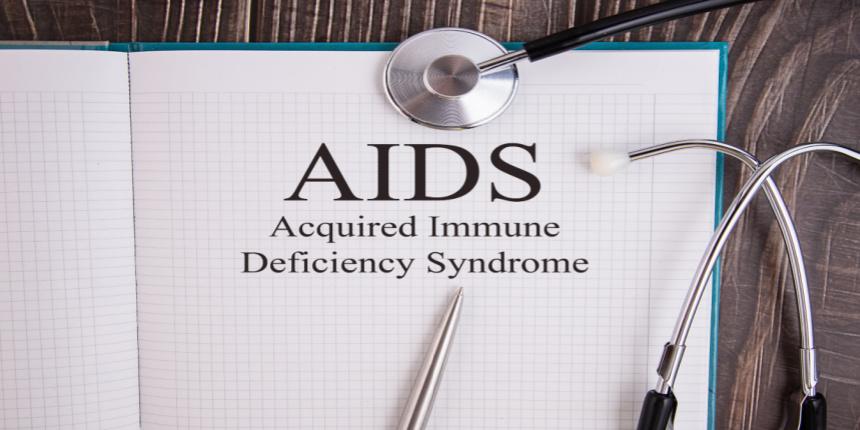AIDS Full Form
What is the full form of AIDS?
The full form of AIDS is Acquired Immune Deficiency Syndrome. HIV is a virus that causes AIDS. A person's immune system is thus insufficiently strong to defend them from any illness or infection. HIV infection often progresses to AIDS in its latter stages, at which point the patient is unable to protect himself and transmits numerous illnesses. Death results from AIDS when it is not treated.
- What is the full form of AIDS?
- Overview
- How does HIV/AIDS spread?
- Typical AIDS signs
- Therapy for AIDS
- Signs and symptoms of advanced HIV/AIDS
- Stages of HIV/AIDS

A person with AIDS may suffer from a number of illnesses, such as thrush, pneumonia, TB, skin disorders, cytomegalovirus, and toxoplasmosis. There is a higher chance of contracting an illness like cancer or a neurological disorder.
Overview
The human immunodeficiency virus (HIV) is the primary cause of the chronic, possibly fatal illness known as acquired immunodeficiency syndrome (AIDS) (HIV). HIV interferes with your body's capacity to fight sickness and infection by weakening your immune system. HIV (STI) is a sexually transmitted infection. Additionally, it may be transferred by sharing needles, injecting illegal substances, and coming into contact with contaminated blood. Additionally, it can be passed from mother to child when she is pregnant, giving birth, or nursing. Without treatment, it can take years for HIV to progressively impair your immune system to the point where you get AIDS. HIV/AIDS has no known cure; however, drugs help manage the infection and stop the disease's development.
How does HIV/AIDS spread?
In order for infection to occur, blood, sperm, or vaginal fluids from an infected person must enter your body. Having unprotected vaginal, anal, or oral intercourse with an infected individual, sharing contaminated needles and syringes, and receiving blood transfusions are a few situations in which infection can happen. Transmissions from mother to child can occur during pregnancy, birth, and nursing.
Understanding how HIV is not propagated is crucial. Normal physical contact, such as embracing, kissing, or shaking hands, does not transfer HIV. Additionally, it cannot be spread by water, air, or insects.
Additionally, various risk factors raise the probability of HIV infection. These include sharing needles and syringes, engaging in unprotected intercourse, engaging in sexual activity with several people, and having an STI. Regardless of age, colour, sex, or sexual orientation, anybody can get HIV.
Typical AIDS signs
Since AIDS is an illness caused by a virus, the symptoms of an acute HIV infection might be similar to those of the flu or other viral disorders.
Muscle and joint discomfort
Headaches
Diarrhoea
Tiredness
Enlarged lymph nodes
The color red
Evening sweats
A sore throat, etc.
Therapy for AIDS
There doesn't seem to be a definitive or ideal cure or therapy, but with the right diagnosis, care, and support, one might fight it and live a generally safe and happy life.
Someone needs to take the necessary actions and put up with any potential negative outcomes.
Drugs are used to stop the virus from reproducing.
ART is a successful HIV/AIDS treatment (antiretroviral therapy).
Signs and symptoms of advanced HIV/AIDS
Blurry vision
Consistent diarrhoea or chronic
A temperature of more than 37 degrees Celsius (100 degrees Fahrenheit) combined with a dry cough
The act of sweating at night
Perpetual exhaustion
Reduced breath
Swollen glands that linger for weeks
Gain less weight
Small white dots on the tongue and mouth
Stages of HIV/AIDS
Stage 1: primary or acute HIV infection.
After the first infection, some patients get flu-like symptoms. Acute seroconversion is when the immune system creates antibodies against the virus and causes fever, weakness, and a rash. Transmission of HIV/AIDS is more likely at this stage because HIV replicates fast and has a high viral load.
Stage 2: HIV that is chronic or latent but present.
Until they take an HIV test, many infected persons are unaware of their condition. HIV that is chronic might go unnoticed for a very long period of time.
Symptomatic HIV infection is stage three.
Mild and persistent symptoms are caused by the virus' slow replication and immune system harm.
AIDS or the development of AIDS in stage four.
It takes eight to 10 years for AIDS to develop, and each stage is determined by the viral load, CD4 level, and presence of opportunistic diseases. Each stage's growth, length, and physical impact are influenced by variables including general health, lifestyle, and food. Not all HIV patients will go through each stage; long-term non-progressors are HIV patients who do not progress to AIDS despite the absence of medical treatment.
Other Related Full Forms -
Frequently Asked Questions (FAQs)
Furthermore, acquired immunodeficiency syndrome (AIDS) is a chronic, sometimes fatal illness caused by HIV. HIV targets the immunological cells in the body, causing the immune system to deteriorate. Advanced HIV is referred to as AIDS. Low CD4 count, high viral load, and opportunistic illnesses are some of its symptoms.
Fevers, chronic diarrhoea, night sweats, enlarged lymph nodes, white patches, generalised weakness, muscle and joint difficulties, weight loss, and skin rashes are all indications that AIDS may be present. Herpes zoster can occasionally cause shingles, pneumonia, and oral thrush. Only testing can determine whether you are affected.
There is currently no treatment for AIDS, but businesses are working on an AIDS and HIV vaccine. Antiretroviral treatment (ART) has changed the paths of HIV patients' lives. ART and early detection lower the risk of AIDS and other opportunistic illnesses.
Opportunistic infections are conditions that commonly happen and have negative effects on HIV patients because they have impaired immune systems. These illnesses are side effects of AIDS.